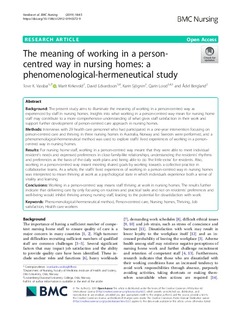| dc.contributor.author | Vassbø, Tove Karin | |
| dc.contributor.author | Kirkevold, Marit | |
| dc.contributor.author | Edvardsson, David | |
| dc.contributor.author | Sjögren, Karin | |
| dc.contributor.author | Lood, Qarin | |
| dc.contributor.author | Bergland, Ådel | |
| dc.date.accessioned | 2019-12-06T09:23:37Z | |
| dc.date.available | 2019-12-06T09:23:37Z | |
| dc.date.created | 2019-10-15T09:49:19Z | |
| dc.date.issued | 2019 | |
| dc.identifier.citation | BMC Nursing. 2019, 18:45 1-8. | nb_NO |
| dc.identifier.issn | 1472-6955 | |
| dc.identifier.uri | http://hdl.handle.net/11250/2632117 | |
| dc.description.abstract | Background The present study aims to illuminate the meaning of working in a person-centred way as experienced by staff in nursing homes. Insights into what working in a person-centred way mean for nursing home staff may contribute to a more comprehensive understanding of what gives staff satisfaction in their work and support further development of person-centred care approach in nursing homes. Methods Interviews with 29 health care personnel who had participated in a one-year intervention focusing on person-centred care and thriving in three nursing homes in Australia, Norway and Sweden were performed, and a phenomenological-hermeneutical method was used to explore staffs’ lived experiences of working in a person-centred way in nursing homes. Results For nursing home staff, working in a person-centred way meant that they were able to meet individual resident’s needs and expressed preferences in close family-like relationships, understanding the residents’ rhythms and preferences as the basis of the daily work plans and being able to do ‘the little extra’ for residents. Also, working in a person-centred way meant meeting shared goals by working towards a collective practice in collaborative teams. As a whole, the staffs’ lived experiences of working in a person-centred way in nursing homes was interpreted to mean thriving at work as a psychological state in which individuals experience both a sense of vitality and learning. Conclusions Working in a person-centred way means staff thriving at work in nursing homes. The results further indicate that delivering care by only focusing on routines and practical tasks and not on residents’ preferences and well-being would inhibit thriving among nursing staff, leading to the potential for dissatisfaction with work. | nb_NO |
| dc.description.abstract | The meaning of working in a person-centred way in nursing homes: a phenomenological-hermeneutical study | nb_NO |
| dc.language.iso | eng | nb_NO |
| dc.rights | Attribution-NonCommercial-NoDerivatives 4.0 Internasjonal | * |
| dc.rights.uri | https://creativecommons.org/licenses/by-nc-nd/4.0/ | * |
| dc.subject | Personsentrert sykepleie | nb_NO |
| dc.subject | Sykehjem | nb_NO |
| dc.title | The meaning of working in a person-centred way in nursing homes: a phenomenological-hermeneutical study | nb_NO |
| dc.type | Journal article | nb_NO |
| dc.type | Peer reviewed | nb_NO |
| dc.description.version | publishedVersion | nb_NO |
| dc.source.pagenumber | 1-8 | nb_NO |
| dc.source.volume | 18:45 | nb_NO |
| dc.source.journal | BMC Nursing | nb_NO |
| dc.identifier.doi | 10.1186/s12912-019-0372-9 | |
| dc.identifier.cristin | 1737080 | |
| cristin.unitcode | 230,0,0,0 | |
| cristin.unitname | Lovisenberg diakonale høgskole | |
| cristin.ispublished | true | |
| cristin.fulltext | original | |
| cristin.qualitycode | 1 | |

